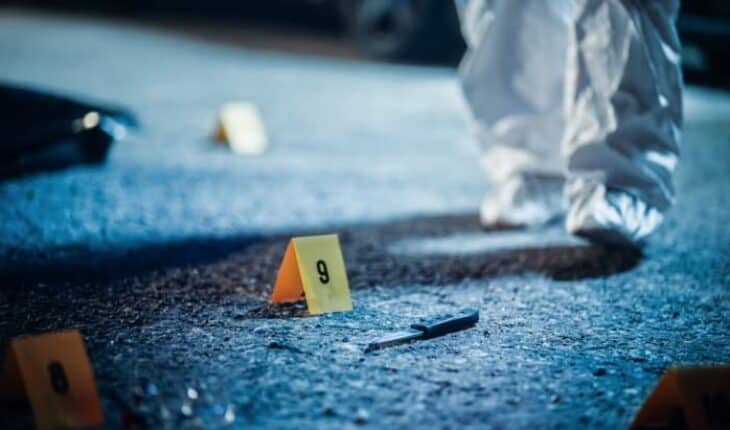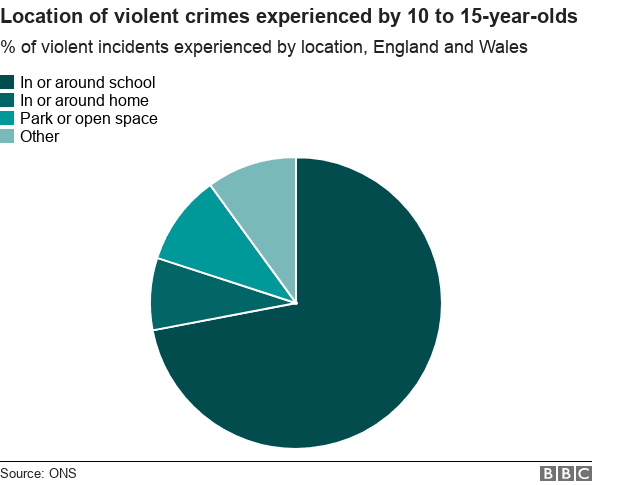Knife crime is on the rise, with more fatalities and injuries among young people than at any other time. What can we do to protect children?
One practical solution is to teach first aid skills in schools, which have seen a rise in the number of violent crime in and around them.
First Aid following a stabbing
Always ensure the area is safe and you are not in any danger, before commencing any first aid.
Protect yourself and wear gloves if possible.
Talk to the casualty and quickly establish if there is any response, or if they are unconscious.
If they are unconscious and breathing, put them into the recovery position and treat any obvious bleeding.
When they are unconscious and not breathing – if there is a life-threatening bleed that you are unable to stop with direct pressure – then this is a catastrophic bleed. Therefore, this is a priority over resuscitation. If there is no obvious pulsating bleed, and they are unconscious and not breathing – then call for an ambulance (and a defibrillator) and commence CPR immediately.
How to stop bleeding
Bleeding can be external (bleeding from an artery or vein) or internal (bleeding into a body cavity).
For an external bleed: Bleeding from a major artery will result in bright red frothy blood that pulsates from the body. This is extremely serious and is a potentially catastrophic bleed. This sort of bleed can kill someone in just a few minutes.
Bleeding from a major vein can also prove fatal. The blood tends to be deep red and flows rather than pulsates. A venous bleed may be easier to stop.
The European Resuscitation Council guidelines on catastrophic bleeding, state that tourniquets and haemostatic dressings should only be used once direct pressure has been tried and been insufficient. Direct pressure to the site of the wound is always the initial first aid intervention of choice for a community first aider.
Click here for Street Crime First Aid including catastrophic bleeding and tourniquets
This is a crime scene!
Remember too that this is a crime scene. Preserve any evidence and don’t interfere with anything or move anything other than what you need to do in order to administer life-saving first aid.
- Wear gloves or take measures to protect yourself from blood contamination.
- Sit or lie the person down – to manage shock and prevent them from feeling dizzy and faint. For a serious bleed, help them lie down and elevate their legs.
- Examine the area to see if there is anything in the wound. If so, do not remove it as it is likely to be stemming bleeding. Apply direct pressure either side of the object. Note that most perpetrators do not leave the weapon in the victim.
- Elevate the bleeding area above the level of the heart to slow down the bleeding (although latest guidelines no longer recommend elevation, as this alone will not stop bleeding). Moreover, they stress that direct pressure is more important. However, new studies have now reinforced medical experience demonstrating that elevation is helpful when attempting to control bleeding.
- Apply direct pressure on the wound to stop the blood coming out.
- Dress the wound with an appropriate non-adherent dressing.
- Keep the casualty warm and reassure them.
Further first aid points to remember when treating a victim of serious bleeding
- Apply direct pressure to try and control bleeding. If you can control the bleeding with pressure, keep holding for 10 minutes as it takes this amount of time for clots to form.
- Keep checking their vital signs, level of consciousness and breathing – expect that they may deteriorate.
- Ensure the emergency services – ambulance and police have been informed.
Catastrophic bleeding – when blood loss is more important than CPR
You can controll most bleeds with direct pressure. However, with a catastrophic bleed, the casualty can lose a critical amount of blood in just 3 minutes.
With an external catastrophic bleed there will be a lot of blood. If the bleed is in a limb and you are unable to stop the bleeding with substantial direct pressure, you may need a tourniquet.
If the bleed is in the trunk of the body, you may need to locate the source of the bleeding by placing your finger or hand into the bleeding cavity. Once you have identified the source of bleeding, the cavity needs to be packed with an improvised or ideally a commercial sterile haemostatic dressing.
To treat an open chest wound it is best not to use airtight dressings. Instead just leave the wound open and control any bleeding with direct pressure or a non-occlusive dressing.
Tourniquets
If someone is bleeding from their limb and the bleed is pulsating and cannot to be stopped with direct pressure, you need to use a tourniquet. A commercial tourniquet will undoubtably be more effective and easier to use; however an improvised tourniquet will work and save lives. 90 percent of victims with potentially survivable wounds die specifically from “uncontrolled” blood loss.
How to use an improvised tourniquet
One of the easiest ways to make an improvised tourniquet from the contents of a standard first aid kit is to use a triangular bandage folded into a broad fold bandage. Then tighten the tourniquet using scissors as a windlass. If you have access to cutlery, such as a table knife, this would be even better; a otherwise you no longer have your scissors available to use.
Please note: A tourniquet should be at least 4cm wide to prevent localised damage to nerve tissues.
- Tie the bandage as quickly and tighlty as possible around the bare limb.
- The tourniquet should be 5-7cm above the wound. Never place a tourniquet over a joint.
- Tighten the tourniquet until the life-threatening bleeding stops. This will be extremely painful to the casualty, explain to the casualty that this is vital to save their life.
- If the bleeding will not stop; try tightening the tourniquet further or apply a second above the first one. Slight bleeding may still continue, but the life- threatening bleeding should be controlled.
- Ensure someone has called 999/112 for help.
- Note the exact time of the application and write this prominently on the tourniquet if possible.
- NEVER release the tourniquet yourself. This should only be done by a healthcare professional in a controlled environment.
If there’s a clean cut through an artery, for example in a deep incised wound, it is possible that the artery can contract back up the arm or leg. This is why you should place the tourniquet at least 5cm (or 2 inches) above the wound.
You may find other guidance on the positioning of a tourniquet, such as applying the first tourniquet mid-point over a single bone. This advice is also acceptable, so long as you position the tourniquet proximal to the wound (closer to the trunk of the body). Previous advice was that tourniquets could only be placed on single bones. It is now known that this is not the case and tourniquets should be placed on lower limbs, if that is where the wound is.
Step by step guide
- Place the knife or your scissors on top of the knot and tie another knot on top of them.
- Use the knife or your scissors as a windlass to wind round and tighten the tourniquet.
3. The windlass can be secured either by tying another triangular bandage to stop it unwinding or by wrapping and tying both ends of the triangular bandage around the ends of the windlass to ensure it remains in place.
It is important to note the exact time that the tourniquet was applied and to arrange for urgent transfer for medical help.Ensure you tell them where and when the tourniquet was applied.
Please note it will be extremely painful for the casualty to have a tourniquet applied. But it is absolutely vital that the tourniquet is applied tight enough to entirely stop the bleeding.
If a tourniquet is not tight enough it can make things worse as it can restrict the veins. However, arteries may be harder to stop as they are less easy to get to. If the venous return is stopped by the tourniquet, the only place for blood to come out is from the wound.
NEVER loosen or remove a tourniquet. Once applied, tourniquets should only ever be removed by a doctor in a hospital setting. Removing a tourniquet outside of a hospital setting is likely to be fatal as accumulated toxins flood the bloodstream.
Unsuitable alternatives for an improvised tourniquet
A tie is likely to be too thin. A leather belt is also unsuitable as it is too tough to use with a windlass; you will be unable to provide sufficient force by hand to tighten it sufficiently to provide enough pressure to stop the blood flow.
A tourniquet should be at least 4cm wide to prevent localised damage to nerves tissues.
Application of a tourniquet
A tourniquet must be sufficiently tight to stop the bleeding. If it is not tight enough it can actually result in increasing blood loss. It may be necessary to apply more than one tourniquet to completely stop bleeding.
It is important for the doctor treating the casualty to have a good understanding of how long the tourniquet has been applied. Write the time you applied the tourniquet onto the tourniquet itself, or onto the casualty.
Please remember that although tourniquets can save lives, their use should not be taken lightly. They remain a second-line treatment when direct pressure is not possible or insufficient to control bleeding.
Click here for Street Crime First Aid including catastrophic bleeding and tourniquets
First Aid training for children
Equipping all children from key stage 2 upwards with basic life support skills and the knowledge to help themselves or others in a medical emergency will save lives. This is relevant training and makes them think twice before equipping themselves with knives, consequently it is an obvious step forward in the fight to reduce fatalities from stabbing.
To learn more about knife crime and the how schools can protect their pupils click here
We also offer a comprehensive, interactive online course – click below to learn more:
- What is a seizure? - 13th March 2025
- Febrile Convulsions and Seizures in Children - 13th March 2025
- Why women are less likely to receive CPR or survive cardiac arrest - 6th March 2025











